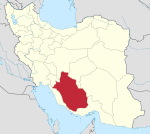art.wikisort.org - Sculpture
Naqsh-e Rajab (Persian: نقش رجب, Persian pronunciation: [næɣʃeɾæˈdʒæb]) is an archaeological site just west of Istakhr and about 5 km north of Persepolis in Fars Province, Iran.



Together with Naqsh-e Rustam, which lies 2.5 km away, the site is part of the Marvdasht cultural complex. Together, the two sites are a tentative candidate for UNESCO World Heritage status.[1]
Naqsh-e Rajab is the site of four limestone rockface inscriptions and rock-cut bas-reliefs that date to the early Sassanid era. One of the carvings is the investiture inscription of Ardeshir I (ruled in 226-241 CE), the founder of the dynasty. The second investiture inscription is Ardeshir's successor, Shapur I (241-272 CE). A third bas-relief, known as 'Shapur's Parade' celebrates the king's military victory in 244 over the Roman emperor Philip the Arab. A fourth bas-relief and inscription is attributed to Kartir, high priest under Shapur I and his sons Hormizd I (272-273 CE) and Bahram I (273–276 CE).
See also
- List of colossal sculpture in situ
- Naqsh-e Rustam
- Taq-e Bostan, another site of Sassanid-era rock reliefs.
References
- "Nasqsh-e Rostam and Naqsh-e Rajab". UNESCO World Heritage Centre.
External links
![]() Media related to Naqsh-e Rajab at Wikimedia Commons
Media related to Naqsh-e Rajab at Wikimedia Commons
На других языках
- [en] Naqsh-e Rajab
[es] Naqsh-e Rajab
Naqsh-e Rajab (en persa:نقش رجب, «el cuadro de Rajab»; Rajab es un personaje desconocido) es el nombre moderno de un conjunto de cuatro bajorrelieves sasánidas del siglo III. El yacimiento arqueológico se encuentra a 3 km al norte de Persépolis y en las proximidades de Naqsh-e Rostam, en Fars, en Irán.Другой контент может иметь иную лицензию. Перед использованием материалов сайта WikiSort.org внимательно изучите правила лицензирования конкретных элементов наполнения сайта.
WikiSort.org - проект по пересортировке и дополнению контента Википедии
